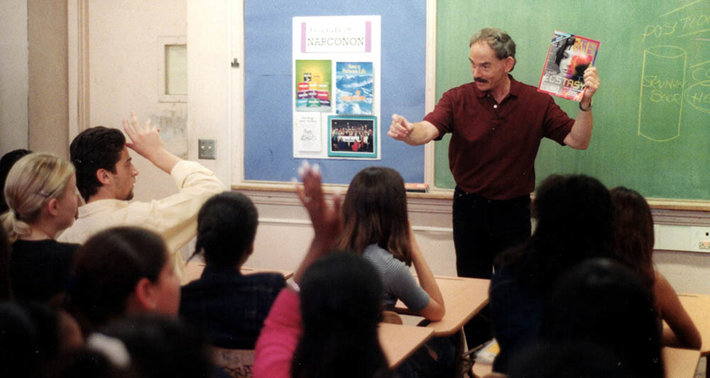Youth Prescription Drug Abuse
As American Youth Suffer Higher Prescription Drug Statistics, Narconon Has Found a Way to Reverse this Damaging Trend

Narconon centers around the world have a drug education curriculum that has proven itself effective in not only changing how young people think about drugs but also how many of them indulge in substance abuse.
Prescription Drug Abuse on the Rise in Recent Years
You don’t have to look far to find out how many of America’s young people are abusing prescription drugs. Fortunately, plenty of people are paying attention.
This includes the CDC, the Centers for Disease Control and Prevention. They recently published the results of a 2009 survey of 16,460 students in grades 9 through 12 from across the US. This survey showed that out of every five children, one of them had abused a prescription drug such as OxyContin, Percocet, Vicodin, Adderall, Ritalin or Xanax. Among white 12th grade students, the rate of students abusing these drugs hit one in four.
As a measure of how fast prescription drug abuse is growing, in 2001, the Department of Justice reported that just 9 percent of high school seniors had abused a prescription drug. All these drugs are known for their addictiveness. Some of them are also known for their ability to kill, particularly OxyContin. As an opioid, OxyContin can suppress respiration to the point that a susceptible person or one who gets too high a dosage will not survive the experience.
“Monitoring the Future” Further Reports Annually on Drug Use by Teens
The “Monitoring the Future” report has come out every year from the University of Michigan, reporting on the substance abuse habits and attitudes of teens. The 2010 report states “It seems likely that young people are less concerned about the dangers of using [psychotherapeutic drugs like amphetamines, sedatives, tranquilizers, and narcotics other than heroin] outside of medical regimen, likely because they are widely used for legitimate purposes. Also, prescription psychotherapeutic drugs are now being advertised directly to the consumer, which implies both that they are used widely and are safe to use.” This report also states that approximately 40 percent of high school seniors feel that it is easy or fairly easy to acquire prescription opiates to abuse.
Aggressive Treatment of Pain Puts More Drugs on the Street
Since 1995, as there began to be a more aggressive attitude toward pain management by medical personnel, the opioid drugs in circulation increased and the number of people abusing these drugs followed. Between 1995 and 2010, opioid painkiller abuse deaths increased ten-fold. This class of drug ended up outstripping heroin and cocaine combined as a killer. Rural American areas such as Kentucky, West Virginia and Tennessee were hit particularly hard. Some people who would never touch heroin feel that a prescription opioid is more acceptable. But ironically, when the price of illicitly-obtained prescription drugs skyrocketed, many of those who had become addicted found themselves using heroin, which was cheaper.
Keeping Young People off Drugs, Prescription and Otherwise
It would be dangerous to assume that teens and even younger children know what decisions to make regarding the abuse of prescription drugs. A report from USA Today described the phenomenon of “pharming,” a party during which young people trade and consume prescription pills they may have harvested from family and friends’ medicine chests. A report from Australia stated that children were swapping prescriptions in the schoolyard in increasing numbers. The drugs most commonly traded were Ritalin, pain medication, and diet pills. And in February 2011, a sixth-grade student in Arizona arrived at school with prescription drugs in his backpack which he then handed out to his fellow students.
Narconon Steps up to Reduce Youth Drug Abuse through a Better Educational Program
For this reason, Narconon centers around the world have provided drug education services to schools, clubs, civic groups and children’s center for decades. Through extensive research and experience, a comprehensive drug education curriculum has been developed that covers a wide range of facts children need to know to stay safe.
Some drug education programs try to scare children with stories of people who have died of overdoses. Other programs insist that kids not do drugs but omit any logical reasons why they should make that decision. Observing that these tactics did not work, Narcononset out to develop a program that would get real results: changed opinions about drug abuse and lower drug use statistics.
The result was the Narconon curriculum of eight classes that thoroughly educate young people on the real ways drug abuse harms them. When students are thoroughly informed of the serious effects of drug use, they can think for themselves and make better decisions.

Narconon Drug Education Curriculum De-Mystifies the Subject
Students receiving the Narconon drug ed curriculum learn how subtle the societal cue can be that invite them to use damaging drugs. Movies, television shows, magazine articles – they can all make drug use look appealing and fun, even if, in some cases, the words that accompany the images damn the activity. Think “Bill and Ted’s Excellent Adventure,” “Fast Times at Ridgemont High” and “Harold & Kumar Go to White Castle.”
One of the most important concepts taught in the Narconon curriculum is that drugs are essentially poisons. So it’s no wonder that a person can die if he gets too much of a drug for his body. Once a young person receives the straight information in a way he can understand it, he can and does start to make better decisions.
Further, the Narconon drug education classes inform students that the effects of substance abuse do not go away as soon as the high wears off. Using graphic examples and audience interaction, Narconon drug educators get their point across that drug residues, being fat-soluble, lodge in the body and can have emotional and mental effects for years, even decades.
By carefully monitoring the results of these classes and comparing attitudes and substance abuse of these students with other students who would not get the classes till later, it was found that actual use statistics were lower for several categories of drugs among the Narconon-taught youth.
An excellent education on drugs and substance abuse is essential for any young person today, given the quantity of illicit and prescription drugs that are circulating, available to anyone who can pay the price.
Resources:
 ®
®